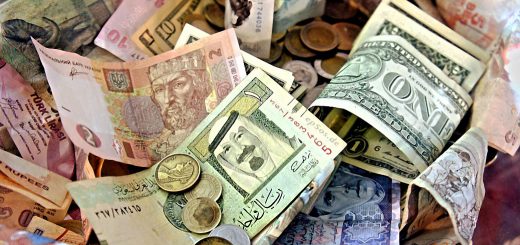What to do About Inflation

Today’s post is about what a private investor can do in response to inflation.
Inflation
This is not a post about whether we are likely to get inflation in the next few years.
- That topic is coming up regularly in the Weekly Roundups, and I’ve written a few supplementary articles on how likely inflation is, and what the underlying mechanisms might be.
Today we’re going to look at what you should invest in if you think that inflation is on the way.
Bonds
The big losers from inflation are bonds.
- As inflation rises, the value of future fixed bond interest payments falls, and so the price of the bond falls.
This pushes the yield of the bond upwards, usually in step with rising interest rates.
- The effect is larger on longer-dated bonds.
Short-term bonds will be much less affected, but returns here are close to zero.
- High yield bonds are also less-affected, but here you have credit risk.
This risk is a particular problem for safety assets like medium-term US Treasuries.
These are currently seen as a safe haven – the “anti-fragile” asset – and when this perception changes, the re-pricing could be extended and extensive.
- It makes sense when you think about it since governments often deliberately use inflation to reduce the real value of their borrowings.
The exception to this rule about bonds is index-linked bonds, also known as linkers, or as TIPS in the US.
- These should hold their value as inflation rises.
I’m tracking a few index-linked bond ETFs, and for now, their prices are still falling.
- There are more complicated ways to access floating-rate bonds and loans, but they have few advantages over TIPs and linkers.
It’s also worth watching TINF – the Tabula US Enhanced Inflation ETF.
This combines TIPS with a form of breakeven inflation expectation.
- TINF goes long the US Government Inflation-Linked 7-10 Year index and short US real yields through the US Treasury 7-10 Year index, with monthly rebalancing.
TINF is trending mildly upwards since its launch at the end of last year.
Diversification
The negative impact of inflation on traditional bonds is also a problem for the industry-standard “diversified” portfolio, which is 60% stocks, 40% bonds.
- And protection from this approach relies on inverse correlations between stocks and bonds, which are not present over the long run, but which has been the case during recent decades which future falling bond yields.
The return of inflation and potentially rising bond yields might be expected to break this recent relationship.
- So I will be taking diversification as far as I can (over asset classes, geographies and time-scales) rather than relying on a simple stock/bond split.
Cash
Cash is another big loser from inflation.
- It should do slightly better than bonds since higher interest rates normally mean that short-term returns are boosted.
A prolonged bout of inflation is bad for cash, though.
The obvious answer is to hold less cash, but an alternative would be to hold currencies other than Sterling from countries with lower inflation.
- This is FX trading rather than inflation hedging, but multi-currency accounts make it easy to move between currencies at close to the institutional exchange rate.
The bad news is that Sterling has been strong in recent months, with only the commodity-driven Aussie dollar making (modest) gains against it.
- I’m keeping an eye on FX rates nonetheless.
You could also go a step further and take out some debt, ideally used to finance the purchase of an asset that might increase in price under inflation.
- The value of the debt would remain constant, and your equity would grow.
I have my eye on a seaside holiday cottage for this purpose, but I’d like to be further into a vaccine recovery – and have greater visibility of the Chancellor’s post-pandemic tax policies – before pulling the trigger.
Stocks
Stocks cope reasonably well with moderate inflation and tend to suffer as inflation rates get higher (above 5% pa).
- There’s also a sector rotation play here.
Higher inflation will lower the value of future profits and earnings relative to current ones.
- Which makes a rotation from growth stocks to value stocks plausible.
High inflation also provides an advantage to firms who have pricing power (can raise the prices that they charge to their customers) and to defensive sectors like utilities and consumer basics.
- Financials should also do well if/when higher inflation leads to higher interest rates (which increases their spreads/profit margins).
Companies with large cash piles (often tech firms) won’t like higher inflation.
- Whereas companies with lots of assets and lots of debts (say commodities firms) should do well, as the assets increase in price and the debt stays the same.
It’s worth noting the preponderance of such firms in the FTSE-100 index, though Sterling strength – which reduces the value of international earnings – is something to watch out for here.
Gold
Gold is often seen as a good inflation hedge, but this only really applies over the long-term.
- In general, when inflation goes up, so do interest rates, which means that assets that offer no yield (such as gold) become less attractive.
But if we were to get inflation plus yield curve control – or very extensive or prolonged inflation – perhaps gold would do OK.
- The gold price is currently falling, and I won’t be increasing or decreasing my (modest) gold allocation in response to the inflation threat at the moment.
If I do make a change, it will probably be to slowly add.
Crypto
In the context of inflation, I’m going to bundle crypto (which at the moment basically means bitcoin) in with gold.
- There’s no reason to believe that BTC would protect against inflation (other than via a continuing bull market, which we have at the time of writing).
The bitcoin price is also much more volatile than the gold price, and crypto has no track record as a long-term store of wealth.
- So I won’t be using crypto as an inflation hedge.
Art
Another alternative to gold is SWAG – this used to mean Stamps, Wine, Art and Gold.
Art is the one we’ll focus on here.
- It has a good track record of non-correlated returns, but the good stuff is too pricey for most of us.
I’ll be taking a look at the fractional ownership platform Masterworks in a future post.
- But if you like art, it can offer some inflation protection (for a very small part of your overall portfolio, of course).
Commodities
Commodities tend to do well under inflation, and in fact, they are a leading indicator.
- When the price of raw materials increases, this will be passed on in the prices of the products they are used to produce.
You can access lots of commodities through ETFs these days, and I also do some trend-following of commodity prices using spread bets.
Real Estate
Real Estate can be a good inflation hedge, but there are two caveats:
- Many people, particularly in the south of England, are already over-exposed to property due to the high costs of residential housing.
- Note that if inflation returns, owning a home (especially with a lot of leverage in the form of a mortgage) should outperform renting.
- The Covid pandemic has placed a question mark against property valuations and rental yields.
I am personally overweight in real estate but if I were looking to add, I would be choosy about sub-sectors.
- Social housing and distribution warehouses look like reasonable bets.
A more radical way to allocate to property would be some kind of rental business.
- Running a buy-to-let business sounds like a full-time job to me, and the tax breaks (and public approval) for this approach are being removed.
But maybe a rental holiday cottage could still work.
- This is no short-term fix, though – transaction costs are high and you would need to commit for quite a few years.
And you are still hoping that UK holidays retain pricing power.
Or you could go the whole hog and buy some land.
- Farmland and forestry come with tax breaks for income and inheritance, but you need to spend big to reach an efficient economic scale.
Fractional ownership hasn’t arrived on this side of the pond, (( See FarmTogether in the US )) so this isn’t an option for most of us.
Conclusions
That’s it for today – we might return to the topic if inflation looks more likely, or actually appears.
- At present, my only mitigation is slightly greater exposure to commodities.
I am watching gold, FX and TIPs/TINF, and could add in these areas in the coming months.
- Until next time.

















No good options then.
Perhaps it is a question of developing some form of least worse approach?
No good options for set and forget. It all depends on how high it gets and for how long.